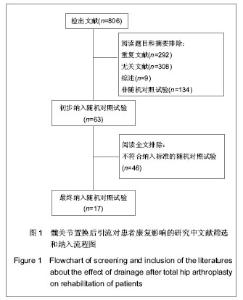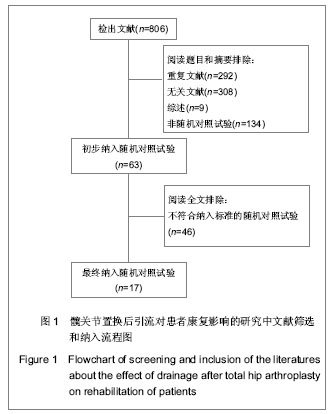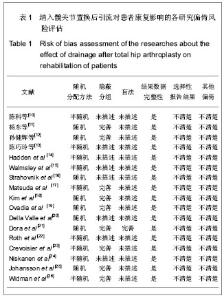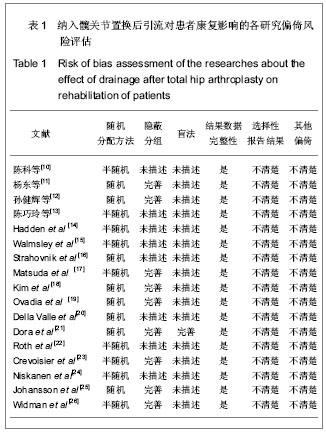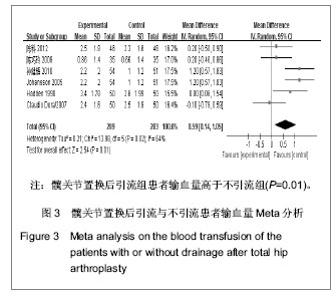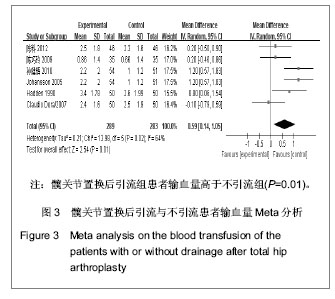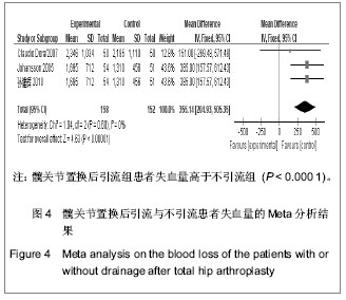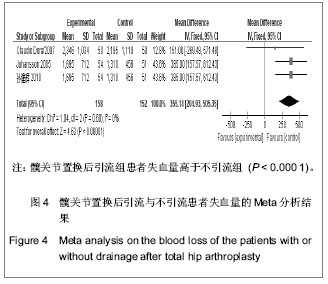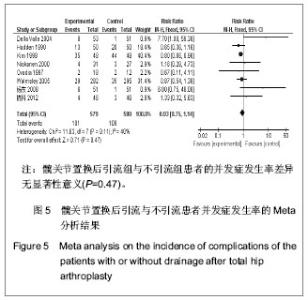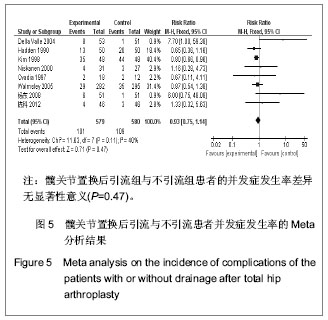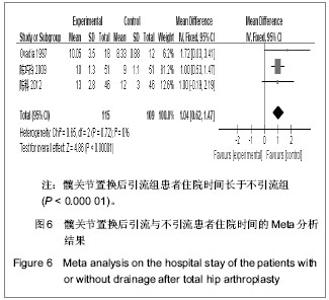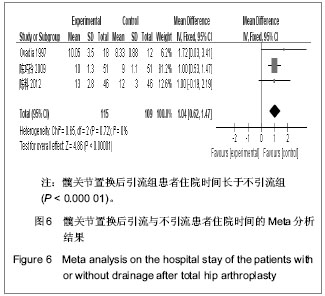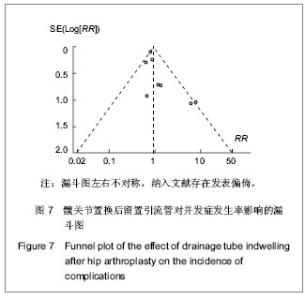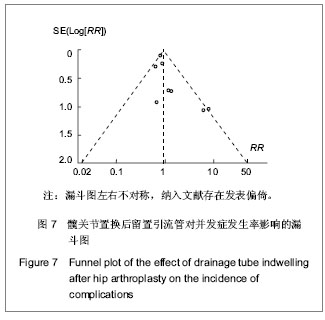Chinese Journal of Tissue Engineering Research ›› 2013, Vol. 17 ›› Issue (35): 6300-6305.doi: 10.3969/j.issn.2095-4344.2013.35.013
Previous Articles Next Articles
Systematic review on the effect of drainage on the rehabilitation of the patients after total hip arthroplasty
Tian Ren-yuan1, 2, Ye Peng1, Deng Jiang2, Huang Wen-liang2, Ma Li-kun1, Lü Xue-feng1
- 1Postgraduate School of Zunyi Medical College, Zunyi 563003, Guizhou Province, China; 2Department of Bone and Joint Surgery, the Third Affiliated Hospital of Zunyi Medical College, Zunyi 563002, Guizhou Province, China
-
Received:2013-05-22Revised:2013-06-05Online:2013-08-27Published:2013-08-27 -
Contact:Deng Jiang, Professor, Master’s supervisor, Department of Bone and Joint Surgery, the Third Affiliated Hospital of Zunyi Medical College, Zunyi 563002, Guizhou Province, China DJ30666@126.com -
About author:Tian Ren-yuan★, Studying for master’s degree, Postgraduate School of Zunyi Medical College, Zunyi 563003, Guizhou Province, China; Department of Bone and Joint Surgery, the Third Affiliated Hospital of Zunyi Medical College, Zunyi 563002, Guizhou Province, China trytian88@163.com
CLC Number:
Cite this article
Tian Ren-yuan, Ye Peng, Deng Jiang, Huang Wen-liang, Ma Li-kun, Lü Xue-feng. Systematic review on the effect of drainage on the rehabilitation of the patients after total hip arthroplasty[J]. Chinese Journal of Tissue Engineering Research, 2013, 17(35): 6300-6305.
share this article
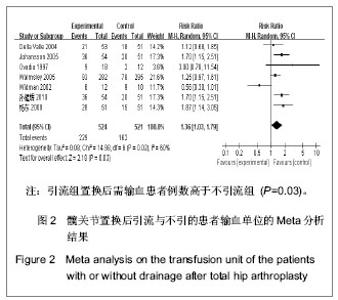
2.2.1 研究设计 最终纳入的17个随机对照试验均为随机平行对照研究[10-26]。有1个随机对照试验用随机数字表产生随机序列[12],2个随机对照试验采用的是计算机软件产生随机序列[18, 20],5个随机对照试验采用随机抽签的方法分组[11, 16, 19, 21, 25],4个随机对照试验是按患者入院单双日或入院先后随机分组[10, 14-15, 17],有5个随机对照试验只进行了随机分组[13, 22-24, 26],未说明具体的随机方法。9个随机对照试验按顺序编号、密封、不透光的信封进行隐蔽分组[11-12, 17-19, 21, 23, 25-26];仅1个随机对照试验报道置换后采用盲法[21],16个随机对照试验未说明是否采用盲法[10-20, 22-26]。 2.2.2 研究对象 共纳入行髋关节置换患者1 838例,不引流组919例,引流组919例,研究地点均为骨科。所有研究均报告了引流组与不引流组基线资料的统计学检验,每个研究两组基线资料都有可比性。 2.2.3 干预措施 所纳入的17个随机对照试验中,实验组髋关节置换后予伤口不留置引流管引流,对照组髋关节置换后予引流管引流。 2.3 Meta分析结果 2.3.1 置换后需输血患者例数 有7个研究比较了髋关节置换后引流与不引流两种治疗方法需要输血患者的人数,共纳入1 045例患者,不引流组524例,引流组521例[11, 15-16, 19-20, 25-26]。所纳入6个研究存在异质性(异质性检验:P=0.02,I2=60%)[11-12, 15, 19-20, 25-26],因此合并效应量RR采用随机效应模型。结果显示,引流组与不引流组置换后需输血患者例数差异有显著性意义(RR=1.36,95%CI:1.03-1.79,P=0.03),见图2。"
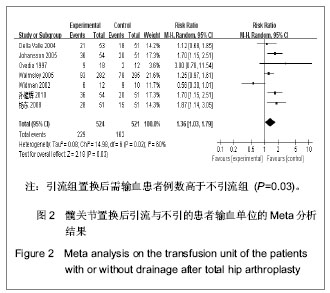

2.2.1 研究设计 最终纳入的17个随机对照试验均为随机平行对照研究[10-26]。有1个随机对照试验用随机数字表产生随机序列[12],2个随机对照试验采用的是计算机软件产生随机序列[18, 20],5个随机对照试验采用随机抽签的方法分组[11, 16, 19, 21, 25],4个随机对照试验是按患者入院单双日或入院先后随机分组[10, 14-15, 17],有5个随机对照试验只进行了随机分组[13, 22-24, 26],未说明具体的随机方法。9个随机对照试验按顺序编号、密封、不透光的信封进行隐蔽分组[11-12, 17-19, 21, 23, 25-26];仅1个随机对照试验报道置换后采用盲法[21],16个随机对照试验未说明是否采用盲法[10-20, 22-26]。 2.2.2 研究对象 共纳入行髋关节置换患者1 838例,不引流组919例,引流组919例,研究地点均为骨科。所有研究均报告了引流组与不引流组基线资料的统计学检验,每个研究两组基线资料都有可比性。 2.2.3 干预措施 所纳入的17个随机对照试验中,实验组髋关节置换后予伤口不留置引流管引流,对照组髋关节置换后予引流管引流。 2.3 Meta分析结果 2.3.1 置换后需输血患者例数 有7个研究比较了髋关节置换后引流与不引流两种治疗方法需要输血患者的人数,共纳入1 045例患者,不引流组524例,引流组521例[11, 15-16, 19-20, 25-26]。所纳入6个研究存在异质性(异质性检验:P=0.02,I2=60%)[11-12, 15, 19-20, 25-26],因此合并效应量RR采用随机效应模型。结果显示,引流组与不引流组置换后需输血患者例数差异有显著性意义(RR=1.36,95%CI:1.03-1.79,P=0.03),见图2。"


2.2.1 研究设计 最终纳入的17个随机对照试验均为随机平行对照研究[10-26]。有1个随机对照试验用随机数字表产生随机序列[12],2个随机对照试验采用的是计算机软件产生随机序列[18, 20],5个随机对照试验采用随机抽签的方法分组[11, 16, 19, 21, 25],4个随机对照试验是按患者入院单双日或入院先后随机分组[10, 14-15, 17],有5个随机对照试验只进行了随机分组[13, 22-24, 26],未说明具体的随机方法。9个随机对照试验按顺序编号、密封、不透光的信封进行隐蔽分组[11-12, 17-19, 21, 23, 25-26];仅1个随机对照试验报道置换后采用盲法[21],16个随机对照试验未说明是否采用盲法[10-20, 22-26]。 2.2.2 研究对象 共纳入行髋关节置换患者1 838例,不引流组919例,引流组919例,研究地点均为骨科。所有研究均报告了引流组与不引流组基线资料的统计学检验,每个研究两组基线资料都有可比性。 2.2.3 干预措施 所纳入的17个随机对照试验中,实验组髋关节置换后予伤口不留置引流管引流,对照组髋关节置换后予引流管引流。 2.3 Meta分析结果 2.3.1 置换后需输血患者例数 有7个研究比较了髋关节置换后引流与不引流两种治疗方法需要输血患者的人数,共纳入1 045例患者,不引流组524例,引流组521例[11, 15-16, 19-20, 25-26]。所纳入6个研究存在异质性(异质性检验:P=0.02,I2=60%)[11-12, 15, 19-20, 25-26],因此合并效应量RR采用随机效应模型。结果显示,引流组与不引流组置换后需输血患者例数差异有显著性意义(RR=1.36,95%CI:1.03-1.79,P=0.03),见图2。"


2.2.1 研究设计 最终纳入的17个随机对照试验均为随机平行对照研究[10-26]。有1个随机对照试验用随机数字表产生随机序列[12],2个随机对照试验采用的是计算机软件产生随机序列[18, 20],5个随机对照试验采用随机抽签的方法分组[11, 16, 19, 21, 25],4个随机对照试验是按患者入院单双日或入院先后随机分组[10, 14-15, 17],有5个随机对照试验只进行了随机分组[13, 22-24, 26],未说明具体的随机方法。9个随机对照试验按顺序编号、密封、不透光的信封进行隐蔽分组[11-12, 17-19, 21, 23, 25-26];仅1个随机对照试验报道置换后采用盲法[21],16个随机对照试验未说明是否采用盲法[10-20, 22-26]。 2.2.2 研究对象 共纳入行髋关节置换患者1 838例,不引流组919例,引流组919例,研究地点均为骨科。所有研究均报告了引流组与不引流组基线资料的统计学检验,每个研究两组基线资料都有可比性。 2.2.3 干预措施 所纳入的17个随机对照试验中,实验组髋关节置换后予伤口不留置引流管引流,对照组髋关节置换后予引流管引流。 2.3 Meta分析结果 2.3.1 置换后需输血患者例数 有7个研究比较了髋关节置换后引流与不引流两种治疗方法需要输血患者的人数,共纳入1 045例患者,不引流组524例,引流组521例[11, 15-16, 19-20, 25-26]。所纳入6个研究存在异质性(异质性检验:P=0.02,I2=60%)[11-12, 15, 19-20, 25-26],因此合并效应量RR采用随机效应模型。结果显示,引流组与不引流组置换后需输血患者例数差异有显著性意义(RR=1.36,95%CI:1.03-1.79,P=0.03),见图2。"


2.2.1 研究设计 最终纳入的17个随机对照试验均为随机平行对照研究[10-26]。有1个随机对照试验用随机数字表产生随机序列[12],2个随机对照试验采用的是计算机软件产生随机序列[18, 20],5个随机对照试验采用随机抽签的方法分组[11, 16, 19, 21, 25],4个随机对照试验是按患者入院单双日或入院先后随机分组[10, 14-15, 17],有5个随机对照试验只进行了随机分组[13, 22-24, 26],未说明具体的随机方法。9个随机对照试验按顺序编号、密封、不透光的信封进行隐蔽分组[11-12, 17-19, 21, 23, 25-26];仅1个随机对照试验报道置换后采用盲法[21],16个随机对照试验未说明是否采用盲法[10-20, 22-26]。 2.2.2 研究对象 共纳入行髋关节置换患者1 838例,不引流组919例,引流组919例,研究地点均为骨科。所有研究均报告了引流组与不引流组基线资料的统计学检验,每个研究两组基线资料都有可比性。 2.2.3 干预措施 所纳入的17个随机对照试验中,实验组髋关节置换后予伤口不留置引流管引流,对照组髋关节置换后予引流管引流。 2.3 Meta分析结果 2.3.1 置换后需输血患者例数 有7个研究比较了髋关节置换后引流与不引流两种治疗方法需要输血患者的人数,共纳入1 045例患者,不引流组524例,引流组521例[11, 15-16, 19-20, 25-26]。所纳入6个研究存在异质性(异质性检验:P=0.02,I2=60%)[11-12, 15, 19-20, 25-26],因此合并效应量RR采用随机效应模型。结果显示,引流组与不引流组置换后需输血患者例数差异有显著性意义(RR=1.36,95%CI:1.03-1.79,P=0.03),见图2。"


2.2.1 研究设计 最终纳入的17个随机对照试验均为随机平行对照研究[10-26]。有1个随机对照试验用随机数字表产生随机序列[12],2个随机对照试验采用的是计算机软件产生随机序列[18, 20],5个随机对照试验采用随机抽签的方法分组[11, 16, 19, 21, 25],4个随机对照试验是按患者入院单双日或入院先后随机分组[10, 14-15, 17],有5个随机对照试验只进行了随机分组[13, 22-24, 26],未说明具体的随机方法。9个随机对照试验按顺序编号、密封、不透光的信封进行隐蔽分组[11-12, 17-19, 21, 23, 25-26];仅1个随机对照试验报道置换后采用盲法[21],16个随机对照试验未说明是否采用盲法[10-20, 22-26]。 2.2.2 研究对象 共纳入行髋关节置换患者1 838例,不引流组919例,引流组919例,研究地点均为骨科。所有研究均报告了引流组与不引流组基线资料的统计学检验,每个研究两组基线资料都有可比性。 2.2.3 干预措施 所纳入的17个随机对照试验中,实验组髋关节置换后予伤口不留置引流管引流,对照组髋关节置换后予引流管引流。 2.3 Meta分析结果 2.3.1 置换后需输血患者例数 有7个研究比较了髋关节置换后引流与不引流两种治疗方法需要输血患者的人数,共纳入1 045例患者,不引流组524例,引流组521例[11, 15-16, 19-20, 25-26]。所纳入6个研究存在异质性(异质性检验:P=0.02,I2=60%)[11-12, 15, 19-20, 25-26],因此合并效应量RR采用随机效应模型。结果显示,引流组与不引流组置换后需输血患者例数差异有显著性意义(RR=1.36,95%CI:1.03-1.79,P=0.03),见图2。"


2.2.1 研究设计 最终纳入的17个随机对照试验均为随机平行对照研究[10-26]。有1个随机对照试验用随机数字表产生随机序列[12],2个随机对照试验采用的是计算机软件产生随机序列[18, 20],5个随机对照试验采用随机抽签的方法分组[11, 16, 19, 21, 25],4个随机对照试验是按患者入院单双日或入院先后随机分组[10, 14-15, 17],有5个随机对照试验只进行了随机分组[13, 22-24, 26],未说明具体的随机方法。9个随机对照试验按顺序编号、密封、不透光的信封进行隐蔽分组[11-12, 17-19, 21, 23, 25-26];仅1个随机对照试验报道置换后采用盲法[21],16个随机对照试验未说明是否采用盲法[10-20, 22-26]。 2.2.2 研究对象 共纳入行髋关节置换患者1 838例,不引流组919例,引流组919例,研究地点均为骨科。所有研究均报告了引流组与不引流组基线资料的统计学检验,每个研究两组基线资料都有可比性。 2.2.3 干预措施 所纳入的17个随机对照试验中,实验组髋关节置换后予伤口不留置引流管引流,对照组髋关节置换后予引流管引流。 2.3 Meta分析结果 2.3.1 置换后需输血患者例数 有7个研究比较了髋关节置换后引流与不引流两种治疗方法需要输血患者的人数,共纳入1 045例患者,不引流组524例,引流组521例[11, 15-16, 19-20, 25-26]。所纳入6个研究存在异质性(异质性检验:P=0.02,I2=60%)[11-12, 15, 19-20, 25-26],因此合并效应量RR采用随机效应模型。结果显示,引流组与不引流组置换后需输血患者例数差异有显著性意义(RR=1.36,95%CI:1.03-1.79,P=0.03),见图2。"

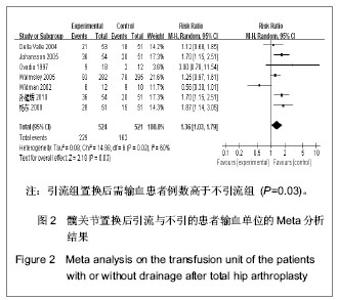
2.2.1 研究设计 最终纳入的17个随机对照试验均为随机平行对照研究[10-26]。有1个随机对照试验用随机数字表产生随机序列[12],2个随机对照试验采用的是计算机软件产生随机序列[18, 20],5个随机对照试验采用随机抽签的方法分组[11, 16, 19, 21, 25],4个随机对照试验是按患者入院单双日或入院先后随机分组[10, 14-15, 17],有5个随机对照试验只进行了随机分组[13, 22-24, 26],未说明具体的随机方法。9个随机对照试验按顺序编号、密封、不透光的信封进行隐蔽分组[11-12, 17-19, 21, 23, 25-26];仅1个随机对照试验报道置换后采用盲法[21],16个随机对照试验未说明是否采用盲法[10-20, 22-26]。 2.2.2 研究对象 共纳入行髋关节置换患者1 838例,不引流组919例,引流组919例,研究地点均为骨科。所有研究均报告了引流组与不引流组基线资料的统计学检验,每个研究两组基线资料都有可比性。 2.2.3 干预措施 所纳入的17个随机对照试验中,实验组髋关节置换后予伤口不留置引流管引流,对照组髋关节置换后予引流管引流。 2.3 Meta分析结果 2.3.1 置换后需输血患者例数 有7个研究比较了髋关节置换后引流与不引流两种治疗方法需要输血患者的人数,共纳入1 045例患者,不引流组524例,引流组521例[11, 15-16, 19-20, 25-26]。所纳入6个研究存在异质性(异质性检验:P=0.02,I2=60%)[11-12, 15, 19-20, 25-26],因此合并效应量RR采用随机效应模型。结果显示,引流组与不引流组置换后需输血患者例数差异有显著性意义(RR=1.36,95%CI:1.03-1.79,P=0.03),见图2。"
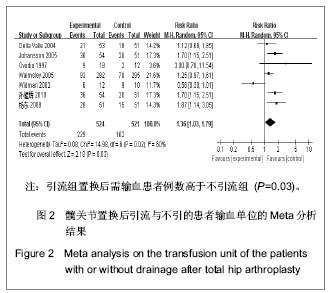
| [1] 杨建平,徐燕,王黎明.骨髓间充质干细胞治疗股骨头坏死的进展[J].中国组织工程研究与临床康复,2007,11(15):2955- 2959.[2] 邓江,韩小松,徐林,等.髋关节置换治疗老年性股骨颈骨折的体会[J].贵州医药,2004,28(8):721-722.[3] 杨祖清,余国荣.骨髓间充质干细胞移植治疗股骨头坏死的研究进展[J].湖北医药学院学报,2011,30(4):434-438.[4] 李真.髋关节损伤和人工材料的修复与移植[J].中国组织工程研究,2012,16(8):1475-1478.[5] 高辉,何澄,黄为民,等.髋关节置换后并发症:基于SCI数据库的文献分析[J].中国组织工程研究,2012,16(22):4133-4142.[6] 阮世强,邓江,徐林,等.髋关节置换与空心拉力螺钉内固定治疗老年股骨颈骨折的疗效比较[J].中国中医骨伤科杂志,2010, 18 (12): 24-26.[7] Waugh TB, Stinchfield FE. Suction drainage of orthopaedic wounds. J Bpne Surg Am. 1961;43:939-946.[8] Drinkwater CJ, Neil MJ. Optimal timing of wound drain removalfollowing total joint arthroplasty. J Arthropalsty. 1995; 10(20):185-189.[9] Crevoisier XM, Reber P, Noesberger B. Is suction drainage necessary after total joint arthroplasty? A prospective study. Arch Orthop Trauma Surg. 1998;117(3):121-124.[10] 陈科,吕小华,曾荣,等.初次全髋关节置换后不放置引流管的安全性[J].中国组织工程研究,2012,16(35):6494-6497.[11] 杨东,张伟,孙水,等.初次全髋关节置换后引流管应用的必要性探讨[J].山东医药,2008,48(18):88-89.[12] 孙建辉.加加压包扎与负压引流预防全髋关节置换后失血量效果比较[J].实用医药杂志,2010,27(3):202-204.[13] 陈巧玲.全小明.等.全髋关节置换后引流放置的对比研究[J].护士进修杂志,2009,24(4):295-296.[14] Hadden WA, McFarlane AG. A comparative study of closed-wound suction drainage vs. no drainage in total hip arthroplasty. J Arthroplasty. 1990;5 Suppl:S21-S24.[15] Walmsley PJ, Kelly MB, Hill RM, et al. A prospective, randomised, controlled trial of the use of drains in total hip arthroplasty. J Bone Joint Surg Br. 2005;10(87):1397-1401.[16] Strahovnik A, Fokter SK, Kotnik M. Comparison of drainage techniques on prolonged serous drainage after total hip arthroplasty. J Arthroplasty. 2010;2(25)244-248.[17] Matsuda K, Nakamura S, Wakimoto N, et al. Drainage does not increase anemia after cementless total hip arthroplasty. Clin Orthop Relat Res. 2007;485:101-105.[18] Kim YH, Cho SH, Kim RS et al. Drainage versus nondrainage in simultaneous bilateral total hip arthroplasties. J Arthroplasty. 1998;2(13):156-161.[19] Ovadia D, Luger E, Bickels J, et al. Efficacy of closed wound drainage after total joint arthroplasty a prospective randomized study. J Arthroplasty. 1997;3(12):317-321.[20] González Della Valle A, Slullitel G, Vestri R, et al. No need for routine closed suction drainage in elective arthroplasty of the hip: a prospective randomized trial in 104 operations. Acta Orthop Scand. 2004;75(1):30-33.[21] Dora C, Campe AV, Mengiardi B, et al. Simplified wound care and earlier wound recovery without closed suction drainage in elective total hip arthroplasty. A prospective randomized trial in 100 operations. Arch Orthop Trauma Surg. 2007;127(10): 919-923.[22] Roth PV, Perka C, Dirschedl K et al. Use of redon drains in primary total hip arthroplasty has no clinically relevant benefits. 2012;35(11):e1592-e1595.[23] Crevoisier XM, Reber P, Noesberger B. Is suction drainage necessary after total joint arthroplasty? A prospective study. Arch Orthop Trauma Surg. 1998;117(3):121-124.[24] Niskanen OR, Korkala OL, Haapala J, et al. Drainage is of no use in primary uncomplicated cemented hip and knee arthroplasty for osteoarthritis a prospective randomized study. J Arthroplasty. 2000;5(12):567-569.[25] Johansson T, Engquist M, Pettersson LG, et al. Blood loss after total hip replacement a prospective randomized study between wound compression and drainage. J Arthroplasty. 2005;8(20):967-971.[26] Widman J, Jacobsson H, Larsson SA, et al. No effect of drains on the postoperative hematoma volume in hip replacement surgery. A randomized study using scintigraphy. Acta Orthop Scand. 2002;73(6):625-629. |
| [1] | Zhu Shi-bai, Zhai Jie, Jiang Chao, Ye Can-hua, Chen Xi, Weng Xi-sheng, Qian Wen-wei. Application of “enhanced recovery after surgery” in the perioperative period of total knee arthroplasty [J]. Chinese Journal of Tissue Engineering Research, 2017, 21(3): 456-463. |
| [2] | Luo Li, Chi Peng-fei, Ma Ming, Zhao Yong, Sun Wu-dong, Huang Hai-yang. Design and analysis of hand rehabilitation training device based on three-dimensional modeling [J]. Chinese Journal of Tissue Engineering Research, 2016, 20(53): 7952-7958. |
| [3] | Zhang Yang-chun, Xiao Jian-hong, Zhang Zi-ji, Yang Xing, Yu Shi-ming, Sheng Pu-yi . Vacuum sealing drainage combined with iodophor douche for the prosthesis infection after artificial joint replacement [J]. Chinese Journal of Tissue Engineering Research, 2016, 20(44): 6549-6556. |
| [4] | Ren Guo-qing, Liu Hong-yun, Teng Xue-ren, Zhang Hai-ning, Lu Jing. Effects of drainage versus nondrainage after total knee arthroplasty: a randomized controlled trial [J]. Chinese Journal of Tissue Engineering Research, 2016, 20(22): 3219-3226. |
| [5] | Zhu Xin-hua, Chai Yi-min, Ye Ji-zhong, Han Pei, Wen Gen, Chen Pei. Vacuum sealing drainage technique versus traditional repair in treatment of diabetic foot [J]. Chinese Journal of Tissue Engineering Research, 2014, 18(34): 5548-5554. |
| [6] | Li Ling-jiang, Chang Heng, Chang Jing-jing, Chen Chuan-jiang, Yuan Long, Wang Ji-rong, Zhang Jiang-hong, Pan Yong-liang, Liu You-hui . Polyethylene ethanol hydration seaweed salt for vacuum sealing drainage in repair of orthopedic wounds [J]. Chinese Journal of Tissue Engineering Research, 2013, 17(47): 8282-8287. |
| [7] | Shi Shi-ping, Li Wei, Zhang Wei, Sun Shui, Wang Chao, Li Hui-bo. Knee osteoarthritis grading affects the hidden hemorrhage after total knee arthroplasty [J]. Chinese Journal of Tissue Engineering Research, 2013, 17(35): 6234-6239. |
| [8] | Xu Jie, Liu Chun-hua, Zhou Shi-guo, Lin Yuan. Total knee arthroplasty: Comparison between quadriceps sparing approach and medial parapatellar approach [J]. Chinese Journal of Tissue Engineering Research, 2013, 17(35): 6240-6246. |
| [9] | Pan Zhao-xun, Sun Chao, Yang Zhen-lei, Yang Xiao-ming, Cui Yan. Impaction bone grafting with morselized bone in total hip revision for acetabular deficiency [J]. Chinese Journal of Tissue Engineering Research, 2013, 17(35): 6247-6253. |
| [10] | Yao Guan-feng, Wang Xin-jia, Luo Bin, Wang Wei-dong, Zeng Ji-can. Combined therapy of implants internal fixation and Halo-vest external fixation for the treatment of subaxial cervical fracture-dislocation [J]. Chinese Journal of Tissue Engineering Research, 2013, 17(35): 6351-6356. |
| [11] | Jiang Jun, Ni Lei. Sodium hyaluronate injection immediately versus 2 weeks after arthroscopic debridement for knee osteoarthritis [J]. Chinese Journal of Tissue Engineering Research, 2013, 17(35): 6375-6380. |
| [12] | Luo Zheng-liang, Shang Xi-fu, Li Xu, Hu Fei, He Rui. Relative factors for osteonecrosis in the Chinese systemic lupus erythematosus patients: Meta-analysis [J]. Chinese Journal of Tissue Engineering Research, 2013, 17(35): 6314-6320. |
| [13] | Bai Wen-yuan, Gu Hong-sheng, Liao Zhen-hua, Liu Wei-qiang. Clinical application of artificial lumbar disc replacement: Present and future [J]. Chinese Journal of Tissue Engineering Research, 2013, 17(35): 6321-6326. |
| Viewed | ||||||
|
Full text |
|
|||||
|
Abstract |
|
|||||
